Spin glass dynamics through the lens of the coherence length
- Texas Materials Institute, The University of Texas at Austin, Austin, TX, United States
Spin glass coherence lengths can be extracted from experiment and from numerical simulations. They encompasses the correlated region, and their growth in time makes them a useful tool for exploration of spin glass dynamics. Because they play the role of a fundamental length scale, they control the transition from the reversible to the chaotic state. This review explores their use for spin glass properties, ranging from scaling laws to rejuvenation and memory.
1 Introduction
The dynamical processes found in spin glasses mimic those from a wide variety of physical systems, not limited to glass formers, polymers, granular materials, phase separation in the early Universe, and the social sciences. Because their dynamical properties can be measured directly, they provide a window into the behavior of far-from-equilibrium systems. This review will explore the spin glass coherence length, ξ(t, tw; H), its definition, extraction from experiment and simulations, and applications. Here, tw is the age of the spin glass system before the measurement time, t begins, and H is the magnetic field. An inherent advantage of the use of ξ(t, tw; H) to describe dynamical properties is that the spin glass transition temperature, Tg is implicit. A precise value of Tg is not required even for explorations close to Tg.
The first explicit experimental procedure for extraction of the spin glass was proposed and demonstrated by Joh et al. [1]. They noted that the relevant free energy barrier energy change from imposition of a magnetic field H was given by what they termed the “Zeeman” energy, EZ where,
Here, Ns is the number of spins in a volume subtended by ξ(t, tw; H), and χFC is the field-cooled susceptibility per spin. They took
where θ is the replicon exponent [3].
The Sherrington-Kirpatrick (SK) infinite range exchange Hamiltonian [4] for spin glasses exhibits states within an ultrametric geometry [5] which has a pictorial equivalent [6] of an hierarchical organization. Free energy barriers separate states with occupancies that increase exponentially with diminishing overlap. The Parisi solution [7, 8] of the SK model are “pure states” separated by infinite barriers. This geometry was shown by analogy to replicate dynamical transitions between states with finite free energy barriers [9]. Putting all these factors together leads to an inflection point in the time dependence of the magnetization, and hence a maximum in the logarithmic derivative of the time dependent magnetization, known as S (t, tw; H), the relaxation function:
Experimentally, the magnetization is measured at constant temperature T after an aging time tw. Empirically, the maximum of S (t, tw; H) occurs at a time t ≈ tw [10] associated with the largest free energy barrier generated by the growth of the spin glass coherence length ξ(t, tw; H) where H is the magnetic field.
In a thermoremanent magnetization (TRM) experiment, H is applied in the paramagnetic state, kept constant as the spin glass is cooled to a temperature T below the condensation temperature Tg, and the magnetization is measured after the time tw when H is changed (most often, cut to zero). In a zero-field cooled (ZFC) experiment, H = 0 initially as the spin glass is cooled to T, and the magnetization measured upon application of H after the time tw. It is important to understand that the free energy barriers are not “chemical” in their origin. Rather, they are created by larger and larger numbers of correlated spins, the volume containing Ns subtended by ξ(t, tw; H) according to Eq. 2.
Thus, the maximum free energy barrier height, Δmax is associated with tw according to an Arrhenius law,
where τ0 is an exchange time usually taken as ℏ/kBTg. From Eq. 1, we can define an “effective” waiting time
where
Combining Eqs 1, 5 enables the only means for extraction of the spin glass coherence length from experiment. In order to keep this value explicit, we shall label it ξZeeman.
Mathematical simulations from the Janus Collaboration [11], using a special purpose computer, can address the value of ξ directly. In temperature cycling experiments that will be addressed below, they project (at least) two different coherence lengths [12].
The first is ξmicro (tw, T), the microscopic coherence length computed directly from the replicon propagator [13, 14] in Eq. 6
where for Ising spins, sx = ±1. The replicon correlator
and
The ξ1,2 (tw, T) is designated as the microscopic coherence length ξmicro (tw, T).
Physically [12], “ξmicro (tw, T) is the size of the (glassy) domains within the sample (it is the largest length scale at which we can regard the system as ordered at time tw.”
Another length scale is introduced in simulations [12] when comparing the same system at two times t1 and t2 (t1 < t2): ζ(t1, t2). It “characterizes the long-distance decay of the pair-correlation function corresponding to the set of spins taking opposite signs at times t1 and t2. Physically, ζ(t1, t2) is the typical size of regions where coherent rearrangements have occurred between times t1 and t2 … because of the ongoing formation of a new spin order at time t2. For fixed t1, ζ(t1, t2) grows with t2 starting from ζ(t1, t2 = t1) = 0.”
At a given temperature, ξZeeman (tw, T) “fairly closely follows the behavior of the microscopic length ξmicro (tw, T)” [12, 17–19] so that, for all practical purposes, they can be taken equal. For varying temperature protocols, the scenario is more intricate because of the presence of temperature chaos at large temperature changes. The length scales are quantitatively compared in Figure 5 of [18].
Now that we have defined the relevant length scales, we show in the next section how they elucidate the dynamical properties of spin glasses.
2 Physical properties
The first experimental extraction of ξZeeman (tw, T) [1] compared results from two approaches: power law dynamics [20] vs. activated dynamics [21]. The results are reproduced in Figure 1. Knowing χFC per spin from other measurements allows for the extraction of ξZeeman (tw, T) from Eq. 2. For example, from Figure 1 at tw = 1, 000 s, Ns ≈ 3 × 106 spins. They set
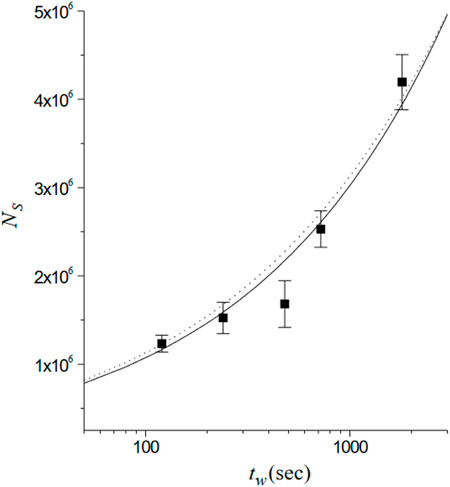
Figure 1. A plot of Ns reproduced from [1] for CuMn 6 al.% vs. tw on a log scale at fixed temperature T = 0.89 Tg = 28 K. The solid curve drawn through the points is the prediction for power law dynamics [20], while the dashed curve is the prediction for activated dynamics [21], with their exchange factor set equal to Tg (i.e., independent of T and t). As is seen from the two curves, the two fits are equally good.
The uses of ξ(tw, T) to describe physical processes provides a powerful quantitative tool. Pertinent examples are described below.
2.1 Slowing down of the growth of ξ(tw, T)
The Janus Collaboration utilizes a special purpose-built computer [16] to examine the dynamics of the Ising spin glass. They were able to explore the (re-normalized) aging rate [22],
The re-normalizing factor T/Tg makes zc (T, ξ) ≈ zc(ξ) [23].
We can rewrite Eq. 9 as Eq. 10,
The aging rate, zc, was found to vary substantially from experiment to experiments, depending upon the temperature and nature of the spin glass sample. For example, for a bulk polycrystalline sample of CuMn (6 at%) [1] found zc = 5.917 at a reduced temperature of T/Tg = 0.89. For a polycrystalline bulk spinel they found zc = 7.576 at a reduced temperature of T/Tg = 0.72.
In thin films [24] found for 11.7 at. % that zc = 9.62 at reduced temperatures of T/Tg = 0.43, 0.59, and 0.78. Working at T/Tg = 0.95 [25], found zc = 6.80 in bulk polycrystalline CuMn (5 at%).
The Janus collaboration [22] found a hint to reconcile these apparently conflicting values from experiment by computing ξ over a temperature range 0.5 ≤ T/Tg ≤ 1. Figure 2 exhibits their results.
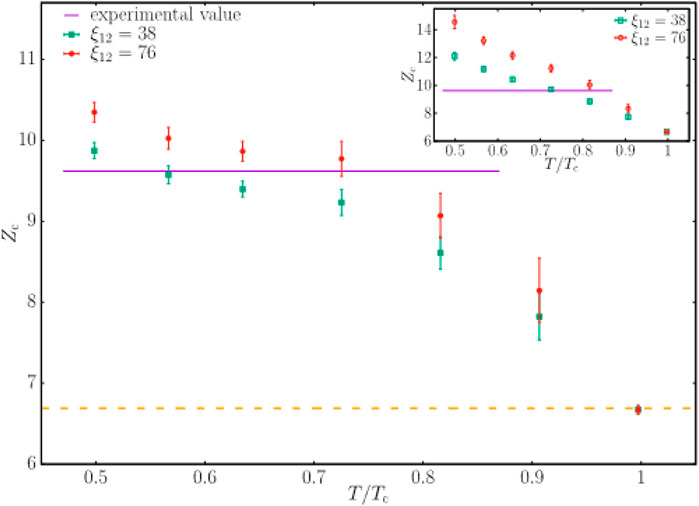
Figure 2. Value of the experimental aging rate for spin glasses Zc(T) = zc (T, ξ)T/Tc, reproduced from Ref. [22]. The straight line is the experimental value of zc(T) ≈ 9.62 from Ref. [23].
Experimentally, there is a significant confirmation for this variation of zc. Ref. [22] found that the growth of ξ(tw, T) slows down as ξ(tw, T) increases. That is, zc increases as ξ(tw, T) increases. In order to achieve large values of ξ(tw, T) to test this simulation prediction, we were blessed with a single crystal of CuMn, 6 at%, grown by Dr. D.L.Schagel, the description of which is contained in Ref. [26]. By working at 28 K (Tg = 31.5 K) and at long waiting times (up to 105 s), the value extracted for ξ(tw, T) reached 150 nm, the largest coherence length ever reported for a glassy system [26]. The value of ξ(tw, T) vs. tw is plotted in Figure 3, from which zc = 12.37 ± 1.07 can be extracted. This is to be compared with zc ≈ 9.62 extracted at shorter waiting times for smaller values of ξ(tw, T).
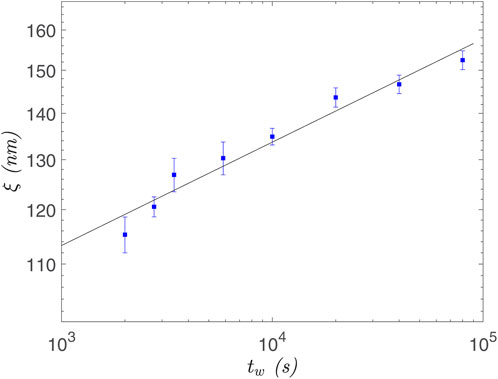
Figure 3. ξ(tw, T) as a function of the waiting time tw at a measuring temperature of T = 28 K (Tg = 31.5 K) reproduced from Ref. [26]. The staight line is a fit to ln tw = (zcTg/T) ln ξ + const. [recall Eq. 10], yielding Zc = 12.37 ± 1.07.
2.2 Scaling law
The coherence length ξ(tw, T) can be measured precisely for spin glasses both in experiment and through simulations. However, known analysis methods lead to discrepancies either for large external magnetic fields or close to the transition temperature. This problem can be solved through introduction of a scaling law that takes into account both the magnetic field and the time-dependent coherence length. This is especially important because temperatures T ≈ Tg are most relevant for the study of glass formers (ξ is restricted to a very narrow window of variation if one moves away from Tg).
Historically, non-linear magnetization effects, and their scaling properties in spin glasses, were first introduced by Malozemoff, Barbara, and Imry [27–29] who introduced the relation for the singular part of the magnetic susceptibility,
where f(x) is a constant for x → 0; f(x) = x−γ for x → ∞; ϕ = γδ/(δ − 1) ≡ βδ; and tr is the reduced temperature T/Tg.
This form was used by Lévy and Ogielski [30], and Lévy [31] who measured the AC non-linear susceptibilities of very dilute AgMn alloys above and below Tg as a function of frequency, temperature, and magnetic field. Their critical exponents from Eq. 11 differed substantially from Monte Carlo simulations for short-range Ising systems [32]. The discrepancy in their value of γ was very large, and most probably arose from the lack of an exact value for Tg in their experiments. This illustrates the value of and need for a different approach for scaling the non-linear magnetization of spin glasses in the vicinity of Tg.
The scaling argument goes as follows. Let M(t, tw; H) be the magnetization per spin. The generalized susceptibilities χ1, χ3, χ5, … are defined through the Taylor expansion,
We have omitted t and tw for brevity. Our hypothesis is that, in the non-equilibrium regime for a spin glass close to Tg in the presence of a small magnetic field,
According to full-aging spin-glass dynamics [30] Eq. 13 tells us that ξ(t + tw)/ξ(tw) will be approximately constant close to the maximum of the relaxation rate [i.e., peak of S(t)], so that we omit this dependence. Thus, combining Eqs 12, 13, one can express the generalized susceptibilities χ1, χ3, χ5, … in terms of the spin glass coherence length ξ(t, tw; H):
where we have omitted the arguments t and H for convenience, and Eq. 15
with
The first term of M(H) in Eq. 12 is χ1, which contains the linear term as well as the first non-linear scaling term, so that we write,
where a1(T) is some unknown constant, hopefully varying smoothly with temperature.
The free-energy variation per spin in the presence of a magnetic field can be derived by integrating the magnetic density Eq. 12 with respect to the magnetic field in Eq. 17,
Substituting the scaling from Eqs 14, 16, the free energy ΔF can be written as (we drop the
where again the an(T) are unknowns and hopefully again smoothly varying functions of temperature. Using the effective response time,
where the coefficient b is a geometrical factor, and we have absorbed the kBT term in the an(T) coefficients. The correction term
where, in Eq. 21
This leads to the new scaling relation,
where the geometrical factor b has been absorbed into the scaling function
Among the many uses of Eq. 22, two can be highlighted. The first is the issue surrounding the magnetization encompassed in ξZeeman (tw, T). The original introduction proposal, Ref. [1], envisaged the reduction of the barrier heights Δ(tw, T) by EZ [Eq. 1] to be caused by the magnetization induced by the magnetic field within the volume subtended by the spin glass coherence length ξ(tw, T), viz Eq. 1. A subsequent treatment [33] associated EZ with the magnetization associated with the fluctuations of the entire system of N spins, namely,
A comparison of the two was exhibited in Fig. 10 of Ref. [17], reproduced here as Figure 4. The magnitude of the magnetic fields contained in Figure 4 are quite large. The authors of Ref. [33] state that the proportionality to H fails at low magnetic fields. The reader can judge whether a linear fit to H is obeyed by the left-hand of Figure 4. The right-hand of Figure 4 is the fit to the scaling law, valid over the full range of H, large and small. Again, the reader can judge which fit is preferable.
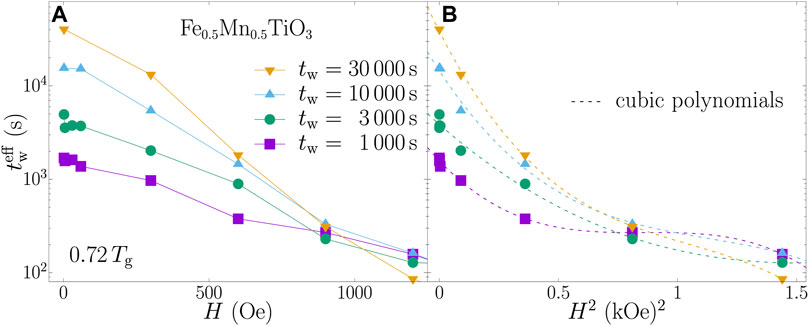
Figure 4. (A) Effective waiting times (log scale) derived from field-change experiments on an Ising sample (Fe0.5Mn0.5TiO3) as a function of magnetic field H. The plot reproduces Figure 10 of Paga et al. [17] (solid lines are linear interpolations to data with the same tw). (B) The same data plotted against H2. The dotted lines are fits to Eq. 19.
The second is the value of the condensation temperature, Tg. In principle, determination of Tg would require an infinite tw because ξ(T) → ∞ when T → Tg. One expects that any experiment at finite tw would yield a maximum for the non-linear susceptibility at a temperature we shall call Tg (tw) because tw is finite.
In principle then, by measuring Tg (tw) for ever larger tw, one could extrapolate to the true tw → ∞ condensation temperature Tg. If nothing else, measurements at large values of tw on laboratory time scales could establish an upper bound for Tg.
The non-linear susceptibility χ3 diverges as Eq. 23
where χ0 is a constant independent of temperature, and γ = 6.13 (11) from Ref. [32]. For finite tW, χ3 (tw, T) only has a maximum as a function of temperature. A way of arriving at this maximum would be to fit the data to the function, in Eq. 24
and then use data points from just two or three temperatures to extract Tg (tw). For larger and larger tw, one could in principle extrapolate to the true Tg. This is just a suggestion for a feasible process for taking laboratory data for finite tw and extrapolating to find Tg (tw → ∞).
2.3 Temperature chaos
Temperature chaos is one of the outstanding mysteries posed by spin glasses. It consists of the complete reorganization of the equilibrium configurations by the slighted change in temperature.” [34] These are the opening lines of a major paper titled “Temperature chaos is a non-local effect” and set the stage for this section. Even the existence of temperature chaos in spin glasses has been questioned [35–38]. Recent experiments [39] and simulations [40] have shed light on its existence and nature, but there are many questions that remain.
From this article’s perspective, the opening gambit was the renormalization group perspective of Bray and Moore [41]. They introduced a length scale associated with temperature chaos that, for all practical purposes, can be simplified to,
where ζ = ds − θ, ds the fractal dimension of the correlated region, and θ is the replicon exponent. The system is in an equilibrium state at a temperature T1, after which the temperature is dropped to T2. Temperature chaos obtains with a length scale ℓc. The reason that ℓc is important is that, for a coherence length ξ(tw, T) not infinite, temperature chaos requires a finite temperature drop. The condiction is, shown in Eq. 26
where by “reversible” we mean that the system “remembers where it came from” when the temperature is dropped from T1 to T2, i.e., no temperature chaos.
Though the relationship Eq. 25 is for a spin glass in equilibrium, realistically, this is never the case. Fortunately, recently an analysis was provided [40] which is titled “Temperature chaos is present in off-equilibrium spin-glass dynamics,” so that we can use the relationship Eq. 25 experimentally. Note that both tw and ΔT = T1 − T2 are controllable parameters. Hence, we can probe the onset of temperature chaos by examining spin glass dynamics under difference conditions, and in particular, can control its onset.
Experiments have probed temperature chaos. The first definitive paper [42] defined the length scale for chaos as LΔT given by Eq. 27,
equivalent to our Eq. 25 with LΔT ≡ ℓc (T1, T2), and J an exchange energy in units of temperature. They extract and effective chaos length scale, Leff from the following plot (their Figure 4, our Figure 5): Their plot generates 1/ζ = 2.6 or ζ = 0.38. This value is a factor of nearly 3 below the rather universally accepted value of ζ = 1.1 (see Appendix B in Ref. [39], for a full listing of theoretical values for ζ).
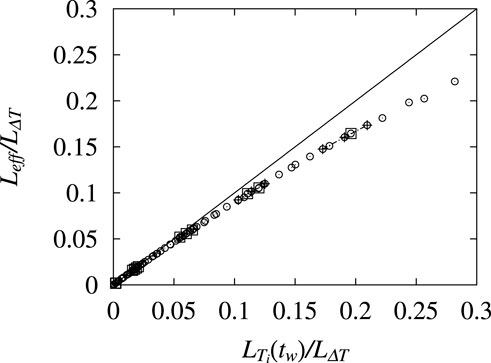
Figure 5. Reproduced from Figure 4 in [42]. Scaling plot of Leff with LΔT = L0 (cΔT/J)−2.6 with c = 5. The solid straight line represents scaling in the absence of temperature chaos.
It is difficult to understand why their value for ζ was so far off from what is now regarded as the fairly accepted value near unity. An origin may be lie in their measurement protocol, namely, a zero-field magnetization measurement where the magnetic field is applied after cycling to T1. Magnetic field chaos [43, 44] could then be compounded with temperature chaos, and distort the extraction of a value for 1/ζ.
In order to circumvent this possibility, Zhai et al. [39] worked with a protocol where the magnetic field remained constant across temperature cycling. The idea was to use the field-cooled magnetization to investigate temperature chaos in spin glasses. This protocol involved turning on a magnetic field H above the condensation temperature, Tg, keeping it constant throughout the temperature cycling protocol.
The specific steps were as follows. The decay of the field cooled (FC) magnetization, MFC(t, T1, H) is measured at the first temperature stop T1 after cooling in the current magnetic field and waiting a time tw1. The decay curve is denoted as the “reference curve.” Then, temperature cycling is engaged, where one first cools to temperature T1, waits a time tw1, cools to T2, waits a time tw2, then rapidly warms back to T1, and measures the decay of the magnetization MFC(t, T1, H).
In order to observe TC, T1 was fixed and the temperature T2 was gradually lowered in separate experimental runs to T2 = T1 − ΔT. Following the temperature drop, if,
the coherence length will continue to grow, and one remains in the reversible state. However, in Eq. 29
temperature chaos sets in and one finds a diminished coherence length after heating back to temperature T1 (see the discussion below of memory).
As a consequence, under reversible dynamics, Eq. 28, the decay curve of MFC(t, T1, H) after temperature cycling can be superposed on the reference decay curve, allowing for a positive shift in time for MFC(t, T1, H) during the time that T < T1. However, after the onset of temperature chaos, The decay curves cannot be superposed for any positive shift of MFC(t, T1, H) in time.
This is seen explicitly in Figure 6 which was reproduced from Figure 1 of Ref [39]. By changing T1, tw1, Eq. 25 can be probed to yield a value for 1/ζ. A value for ζ ≈ 1.1 was extracted in [39], very close to a majority of the theoretical values.
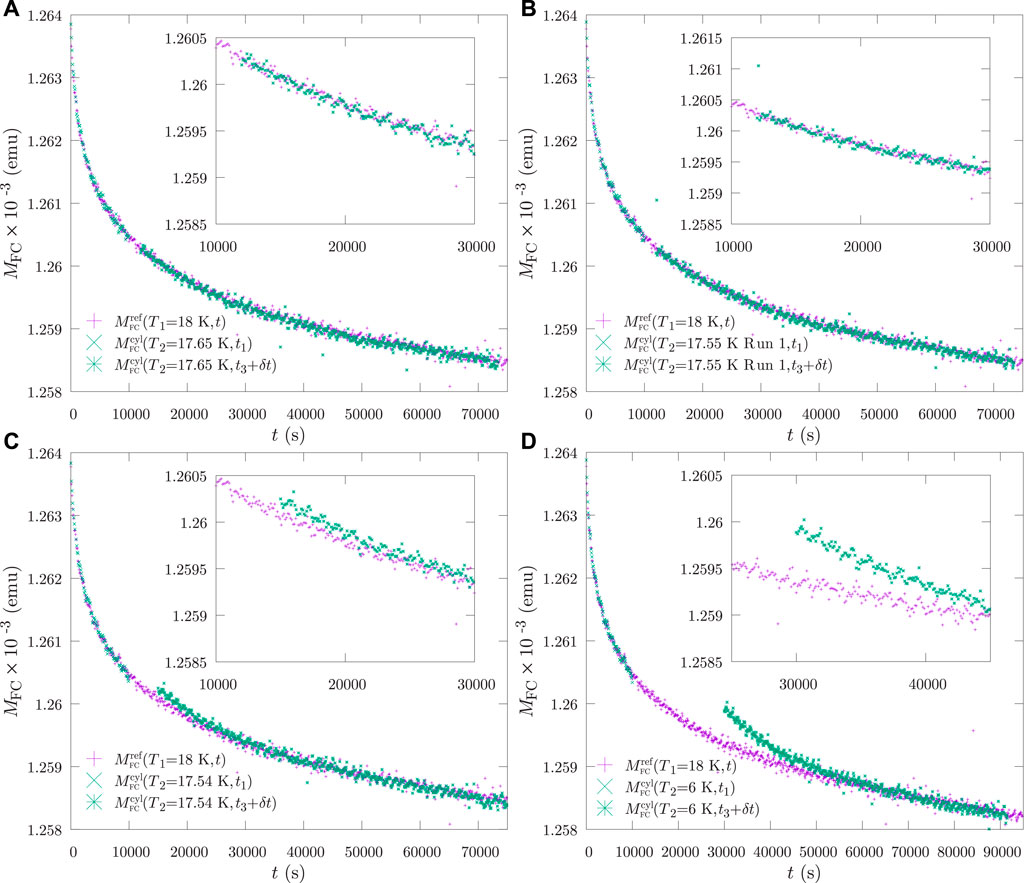
Figure 6. The example of T1 = 18 K, reproduced from Figure 1 in [39]. The temperature is gradually lowered to T2 after tw1 = 104 s and heated back to T1 after tw2 = 103 s. The temperature cycling curve is then shifted by δt to overlap the reference curve. In the reversible temperature range, (A) and (B), the cycling curve can be overlapped with the reference curve over the whole period
This experimental evidence for the existence of temperature chaos in spin glasses will prove important in our subsequent treatments of rejuvenation and memory. We shall argue that temperature chaos is responsible for the former, and plays an important role in a quantitative treatment of the latter. In any case, the experiments of Ref. [34] have shown that temperature chaos is present in spin glasses, and will be shown to have a profound impact in other dynamical spin glass phenomena.
2.4 Rejuvenation
The singular publication that engendered the attention of both theorists and experimentalists for over three decades was that of Jonason et al. [45] titled “Memory and Chaos Effects in Spin Glasses.” They displayed the remarkable figure (Figure 7 reproduced from Figure 1 in their paper). The system is “aged” at 12 K, becoming “older.” Upon lowering the temperature, it returns to the reference curve, thus becoming “younger”. This is termed “rejuvenation.” It was attributed to temperature chaos, namely, the spin glass “forgot” its previous history of aging when the temperature was lowered beyond the threshold for temperature chaos.
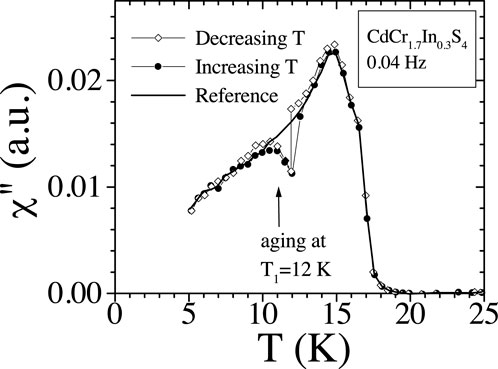
Figure 7. Reproduced from Figure 1 of Ref. [45]. Out-of-phase susceptibility χ′′ of the CdCr1.7In0.3S4 spin glass. The solid line is measured upon heating the sample at a constant rate on 0.1 K/min (reference curve). Open diamonds: the measurement is done during cooling at this same rate, except that the cooling procedure has been stopped at 12 K during 7 h to allow for aging. Cooling then resumes down to 5 K: χ′′ is not influenced and goes back to the reference curve (chaos). This is termed rejuvenation. Solid circles: after this cooling procedure, the data is taken while reheating at the previous constant rate, exhibiting memory of the aging stage at 12 K.
This assignment has yet to be proven unequivocally. A very recent paper [18] by Paga et al. displayed the results of temperature cycling to explore this claim, and indeed to relate rejuvenation to the spin glass coherence length. Figure 8 reproduces their Figure 2. While Figure 8 appears definitive, there needs to be an exploration of
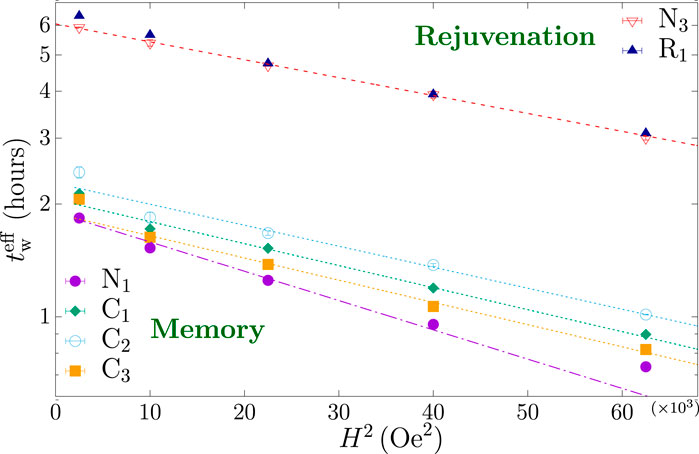
Figure 8. Reproduced from Figure 2 of Ref. [18]. We use the abbreviations N (native), R (rejuvenation), and C (cycle). By native, we mean the temperature is lowered from above Tg (here, Tg = 41.6 K to the lower temperature T2 in the usual cycling protocol (here, T2 = 26 K, tw2 = 3 h), and the effective waiting time is given by the peak in S(t) for different magnetic fields H. The points are labeled N3 in Figure 8. Next, the system is cooled from above Tg to the temperature T1 = 30 K and aged for 1 h. The temperature is then dropped to T2 = 26 K, and aged for 3 h. The points are labelled R1 in Figure 8. As can be seen from the figure, the two procedures yield nearly exactly the same
2.5 Memory
Though rejuvenation in spin glasses is remarkable, the even more remarkable is memory. Once the system has rejuvenated back to the reference curve, upon reheating it traces out the same behavior as it exhibited upon cooling, even with temperature chaos between T1 and T2. This is explicitly demonstrated in Figure 7. On the surface it seems quite inconsistent. How can the system exhibit memory when it has experienced temperature chaos? There have been a multitude of papers and models that addressed this conundrum. Most involve heuristic models with adjustable parameters that can fit the data represented in Figure 7. A recent treatment [18] gives an interpretation that is free of real space models and the concomitant adjustable parameters, and is based upon the behavior of the spin glass coherence length. The beauty of this formulation is that every term in its interpretation can be tested experimentally, something that previous models lack.
The concept is as follows. Upon cooling the spin glass from above Tg to the first measuring temperature T1, the system is aged for a time tw1. As a consequence, the spin glass coherence length grow from nucleation to ξ(tw1, T). When the temperature is then lowered to T2, the correlations created at T1 are essentially frozen. This concept has been introduced by Bouchaud et al. [45]. What is new is that, when the system is aged at T2 for a time tw2, the system has created new coherent regions that have nothing to do with those created at T1. Hence, when heating back to T2, the two correlated regions interfere, thereby reducing the spin glass coherence length from the native value created at T1, tw1.
This is exhibited explicitly in Figure 8 in the lower part of the figure. The Cn represent three separate temperature and waiting time cycles, and illustrate unequivocally the relationship between memory and competing coherence lengths. Each of the cycles has three steps: 1) the system is “prepared” at T1 = 30 K by waiting for the same time tw1 = 1 h 2) The temperature is then dropped to T2 and the system is aged for tw2. 3) The system is than heated back to T1 = 30 K and
Consider C1. The system has “morphed” from the prepared state into a chaotic regime, but only aged for a short time (1/6 h). The coherence length in the chaotic state has grown during this time, so that its interference with the initially prepared coherence length is significant. Hence, the memory is less, exhibited by the shallower slope as compared to the native slope exhibited in Figure 8. Now, C2 increases tw2 to 3 h, so that the coherence length in the chaotic state can grow beyond it is value in C1. This should lead to greater interference, a smaller memory, and a more shallow slope than found for C1. This is explicit in Figure 8.
Finally, the C3 protocol has the same tw2 as C2, but the temperature drop to T2 is much greater, T2 = 16 K. At such a low temperature, the growth of the chaotic coherence length is very slow (almost none), so there should be almost no interference, and the memory should be nearly perfect. This again is explicitly exhibited in Figure 8 where the slope of C3 is close to the slope for the native slope.
These three temperature cycles, and their properties exhibited in Figure 8, are strong evidence for the interpretation of memory through interfering coherence volumes. This is at odds with Ref. [46] where it is argued that the coherence length returned to the native value upon reheating. By adjusting tw2 one can change the value of ξ(T1, tw1, T2, tw2) at will, from no loss to complete loss of memory. This have been born out in our Figure 8, and also in independent experiments by Freedberg et al. [47].
3 Summary
The purpose of this paper is to display spin glass dynamics through the lens of the spin glass coherence length. We have shown how it use can unite the seeming independent features observed both in the laboratory and through simulations. They provide a unifying picture for what seem to be independent complex phenomena.
Data availability statement
The raw data supporting the conclusions of this article will be made available by the authors, without undue reservation.
Author contributions
JH: Visualization, Writing–original draft, Writing–review and editing. RO: Conceptualization, Data curation, Formal Analysis, Funding acquisition, Investigation, Project administration, Resources, Supervision, Validation, Visualization, Writing–original draft, Writing–review and editing.
Funding
The author(s) declare that financial support was received for the research, authorship, and/or publication of this article. This work has been supported by the U.S. Department of Energy, Office of Basic Energy Sciences, Division of Materials Science and Engineering, under Award DE-SC0013599.
Acknowledgments
We thank Dr. I. Paga for a close reading of this manuscript, and for her important insights.
Conflict of interest
The authors declare that the research was conducted in the absence of any commercial or financial relationships that could be construed as a potential conflict of interest.
The handling editor FRT declared a past co-authorship with the author RO.
Publisher’s note
All claims expressed in this article are solely those of the authors and do not necessarily represent those of their affiliated organizations, or those of the publisher, the editors and the reviewers. Any product that may be evaluated in this article, or claim that may be made by its manufacturer, is not guaranteed or endorsed by the publisher.
References
1. Joh YG, Orbach R, Wood GG, Hammann J, Vincent E. Extraction of the spin glass correlation length. Phys Rev Lett (1999) 82:438–41. doi:10.1103/PhysRevLett.82.438
2. Marinari E, Parisi G, Ruiz-Lorenzo J, Ritort F. Numerical evidence for spontaneously broken replica symmetry in 3d spin glasses. Phys Rev Lett (1996) 76:843–6. doi:10.1103/PhysRevLett.76.843
3. Baity-Jesi M, Calore E, Cruz A, Fernandez LA, Gil-Narvion JM, Gordillo-Guerrero A, et al. Matching microscopic and macroscopic responses in glasses. Phys Rev Lett (2017) 118:157202. doi:10.1103/PhysRevLett.118.157202
4. Sherrington D, Kirkpatrick S. Solvable model of a spin-glass. Phys Rev Lett (1975) 35:1792–6. doi:10.1103/PhysRevLett.35.1792
5. Mézard M, Parisi G, Sourlas N, Toulouse G, Virasoro M. Replica symmetry breaking and the nature of the spin glass phase. J Phys France (1984) 45:843–54. doi:10.1051/jphys:01984004505084300
6. Parisi G. Spin glasses and fragile glasses: statics, dynamics, and complexity. Proc Natl Acad Sci (2006) 103:7948–55. doi:10.1073/pnas.0601120103
7. Parisi G. Toward a mean field theory for spin glasses. Phys Lett A (1979) 73:203–5. doi:10.1016/0375-9601(79)90708-4
8. Parisi G. A sequence of approximated solutions to the s-k model for spin glasses. J Phys A: Math Gen (1980) 13:L115–21. doi:10.1088/0305-4470/13/4/009
9. Hammann J, Lederman M, Ocio M, Orbach R, Vincent E. Spin-glass dynamics Relation between theory and experiment: a beginning. Physica A Stat Mech its Appl (1992) 185:278–94. doi:10.1016/0378-4371(92)90467-5
10. Nordblad P, Svedlindh P, Lundgren L, Sandlund L. Time decay of the remanent magnetization in a cumn spin glass. Phys Rev B (1986) 33:645–8. doi:10.1103/PhysRevB.33.645
11. Baity-Jesi M, Baños R, Cruz A, Fernandez L, Gil-Narvion J, Gordillo-Guerrero A, et al. Janus ii: a new generation application-driven computer for spin-system simulations. Comput Phys Commun (2014) 185:550–9. doi:10.1016/j.cpc.2013.10.019
12. Baity-Jesi M, Calore E, Cruz A, Fernandez LA, Gil-Narvion JM, Gonzalez-Adalid Pemartin I, et al. Memory and rejuvenation effects in spin glasses are governed by more than one length scale. Nat Phys (2023) 19:978–85. doi:10.1038/s41567-023-02014-6
13. de Almeida JRL, Thouless DJ. Stability of the sherrington-kirkpatrick solution of a spin glass model. J Phys A: Math Gen (1978) 11:983–90. doi:10.1088/0305-4470/11/5/028
14. De Dominicis C, Giardina I. Random fields and spin glasses: a field theory approach. Cambridge University Press (2006). doi:10.1017/CBO9780511534836
15. Belletti F, Cotallo M, Cruz A, Fernandez LA, Gordillo-Guerrero A, Guidetti M, et al. Nonequilibrium spin-glass dynamics from picoseconds to a tenth of a second. Phys Rev Lett (2008) 101:157201. doi:10.1103/PhysRevLett.101.157201
16. Belletti F, Cruz A, Fernandez LA, Gordillo-Guerrero A, Guidetti M, Maiorano A, et al. An in-depth view of the microscopic dynamics of ising spin glasses at fixed temperature. J Stat Phys (2009) 135:1121–58. doi:10.1007/s10955-009-9727-z
17. Paga I, Zhai Q, Baity-Jesi M, Calore E, Cruz A, Fernandez LA, et al. Spin-glass dynamics in the presence of a magnetic field: exploration of microscopic properties. J Stat Mech Theor Exp (2021) 2021:033301. doi:10.1088/1742-5468/abdfca
18. Collaboration J, Paga I, He J, Baity-Jesi M, Calore E, Cruz A, et al. arxiv: quantifying memory in spin glasses (2023).
19. Paga I, Zhai Q, Baity-Jesi M, Calore E, Cruz A, Cummings C, et al. Superposition principle and nonlinear response in spin glasses. Phys Rev B (2023) 107:214436. doi:10.1103/PhysRevB.107.214436
20. Koper GJM, Hilhorst HJ. A domain theory for linear and nonlinear aging effects in spin glasses. J Phys France (1988) 49:429–43. doi:10.1051/jphys:01988004903042900
21. Fisher DS, Huse DA. Nonequilibrium dynamics of spin glasses. Phys Rev B (1988) 38:373–85. doi:10.1103/PhysRevB.38.373
22. Baity-Jesi M, Calore E, Cruz A, Fernandez LA, Gil-Narvion JM, Gordillo-Guerrero A, et al. Aging rate of spin glasses from simulations matches experiments. Phys Rev Lett (2018) 120:267203. doi:10.1103/PhysRevLett.120.267203
23. Zinn-Justin J. Quantum field theory and critical phenomena. In: International series of monographs on physics. Oxford University Press (2021). General theoretical arguments suggest that zc is is also ξ independent at exactly T = Tg.
24. Zhai Q, Harrison DC, Tennant D, Dahlberg ED, Kenning GG, Orbach RL. Glassy dynamics in cumn thin-film multilayers. Phys Rev B (2017) 95:054304. doi:10.1103/PhysRevB.95.054304
25. Kenning GG, Tennant DM, Rost CM, da Silva FG, Walters BJ, Zhai Q, et al. End of aging as a probe of finite-size effects near the spin-glass transition temperature. Phys Rev B (2018) 98:104436. doi:10.1103/PhysRevB.98.104436
26. Zhai Q, Martin-Mayor V, Schlagel DL, Kenning GG, Orbach RL. Slowing down of spin glass correlation length growth: simulations meet experiments. Phys Rev B (2019) 100:094202. doi:10.1103/PhysRevB.100.094202
27. Malozemoff AP, Barbara B, Imry Y. Further studies of nonlinear susceptibility of GdAl and MnCu spin glasses. J Appl Phys (1982) 53:2205–7. doi:10.1063/1.330818
28. Malozemoff AP, Imry Y, Barbara B. Scaling of susceptibility and the size of the critical region in an amorphous GdAl spin glass (invited). J Appl Phys (1982) 53:7672–7. doi:10.1063/1.330179
29. Chandra P, Coleman P, Ritchey I. The anisotropic kagome antiferromagnet: a topological spin glass? J Phys France (1993) 3:591–610. doi:10.1051/jp1:1993104
30. Lévy LP, Ogielski AT. Nonlinear dynamic susceptibilities at the spin-glass transition of ag:mn. Phys Rev Lett (1986) 57:3288–91. doi:10.1103/PhysRevLett.57.3288
31. Lévy LP. Critical dynamics of metallic spin glasses. Phys Rev B (1988) 38:4963–73. doi:10.1103/PhysRevB.38.4963
32. Baity-Jesi M, Baños RA, Cruz A, Fernandez LA, Gil-Narvion JM, Gordillo-Guerrero A, et al. Critical parameters of the three-dimensional ising spin glass. Phys Rev B (2013) 88:224416. doi:10.1103/PhysRevB.88.224416
33. Bert F, Dupuis V, Vincent E, Hammann J, Bouchaud JP. Spin anisotropy and slow dynamics in spin glasses. Phys Rev Lett (2004) 92:167203. doi:10.1103/PhysRevLett.92.167203
34. Fernandez LA, Marinari E, Martin-Mayor V, Parisi G, Yllanes D. Temperature chaos is a non-local effect. J Stat Mech Theor Exp (2016) 2016:123301. doi:10.1088/1742-5468/2016/12/123301
35. Sasaki M, Nemoto K. Memory effect, rejuvenation and chaos effect in the multi-layer random energy model. J Phys Soc Jpn (2000) 69:2283–90. doi:10.1143/JPSJ.69.2283
36. Sasaki M, Martin OC. Discreteness and entropic fluctuations in generalized-random-energy-model-like systems. Phys Rev B (2002) 66:174411. doi:10.1103/PhysRevB.66.174411
37. Sales M, Bouchaud JP, Ritort F. Temperature shifts in the sinai model: static and dynamical effects. J Phys A: Math Gen (2003) 36:665–84. doi:10.1088/0305-4470/36/3/306
38. Rizzo T. Ultrametricity between states at different temperatures in spin-glasses. Eur Phys J B (2002) 29:425–35. doi:10.1140/epjb/e2002-00274-x
39. Zhai Q, Orbach RL, Schlagel DL. Evidence for temperature chaos in spin glasses. Phys Rev B (2022) 105:014434. doi:10.1103/PhysRevB.105.014434
40. Baity-Jesi M, Calore E, Cruz A, Fernandez LA, Gil-Narvion J, Gonzalez-Adalid Pemartin I, et al. Temperature chaos is present in off-equilibrium spin-glass dynamics. Commun Phys (2021) 4:74. doi:10.1038/s42005-021-00565-9
41. Bray AJ, Moore MA. Chaotic nature of the spin-glass phase. Phys Rev Lett (1987) 58:57–60. doi:10.1103/PhysRevLett.58.57
42. Jönsson PE, Yoshino H, Nordblad P. Symmetrical temperature-chaos effect with positive and negative temperature shifts in a spin glass. Phys Rev Lett (2002) 89:097201. doi:10.1103/PhysRevLett.89.097201
43. Kondor I. On chaos in spin glasses. J Phys A: Math Gen (1989) 22:L163–8. doi:10.1088/0305-4470/22/5/005
44. Billoire A, Coluzzi B. Magnetic field chaos in the sherrington-kirkpatrick model. Phys Rev E (2003) 67:036108. doi:10.1103/PhysRevE.67.036108
45. Jonason K, Vincent E, Hammann J, Bouchaud JP, Nordblad P. Memory and chaos effects in spin glasses. Phys Rev Lett (1998) 81:3243–6. doi:10.1103/PhysRevLett.81.3243
46. Bouchaud JP, Dupuis V, Hammann J, Vincent E. Separation of time and length scales in spin glasses: temperature as a microscope. Phys Rev B (2001) 65:024439. doi:10.1103/PhysRevB.65.024439
Keywords: spin glass dynamics, coherence length, rejuvenation, memory, numerical simulation, scaling law
Citation: He J and Orbach RL (2024) Spin glass dynamics through the lens of the coherence length. Front. Phys. 12:1370278. doi: 10.3389/fphy.2024.1370278
Received: 14 January 2024; Accepted: 20 February 2024;
Published: 20 March 2024.
Edited by:
Federico Ricci-Tersenghi, Sapienza University of Rome, ItalyReviewed by:
Qiang Zhai, Xi’an Jiaotong University, ChinaLuca Leuzzi, National Research Council (CNR), Italy
Copyright © 2024 He and Orbach. This is an open-access article distributed under the terms of the Creative Commons Attribution License (CC BY). The use, distribution or reproduction in other forums is permitted, provided the original author(s) and the copyright owner(s) are credited and that the original publication in this journal is cited, in accordance with accepted academic practice. No use, distribution or reproduction is permitted which does not comply with these terms.
*Correspondence: R. L. Orbach, orbach@utexas.edu
 J. He
J. He R. L. Orbach
R. L. Orbach